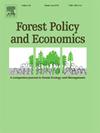成本假设对森林碳目标和供应动态的影响
IF 3.8
2区 农林科学
Q1 ECONOMICS
引用次数: 0
摘要
在评估生态系统服务时,包括显性成本和机会成本可以提供全面的经济评估,但实际应用往往只关注显性成本。本研究考察了阿巴拉契亚中部和南部地区森林碳空间目标和供应动态的演变,从单纯的显性成本方法过渡到纳入加权机会成本的方法。我们通过分析像素级的发展压力来计算机会成本权重,其中每个像素的森林转化率(估计为从森林到城市土地利用的预期转变)作为当地发展压力的指标。这些权重范围从0(没有开发压力)到1(完全开发压力),更高的权重分配给面临更大转换可能性的区域。这种方法在估计基于局部经济压力的机会成本方面提供了灵活性。我们的研究结果表明,纳入机会成本显著影响森林碳供应动态,更高的发展压力导致成本增加和碳储存潜力降低。然而,通过应用加权机会成本,减轻了财政负担,支持了碳储存目标和经济考虑之间的平衡。这些发现表明,森林保护计划将受益于区域调整的激励措施,特别是在高机会成本可能阻止土地所有者参与的发展倾向地区。通过优先考虑具有关键碳储存潜力和高转化风险的地区,保护政策可以最大限度地提高整个阿巴拉契亚地区的环境影响和经济效率。这种方法为既支持碳封存目标,又承认经济权衡的保护政策提供了一条途径。本文章由计算机程序翻译,如有差异,请以英文原文为准。
Impact of cost assumptions on forest carbon targets and supply dynamics
Including both explicit and opportunity costs in valuing ecosystem services offers a comprehensive economic assessment, but practical applications often focus on explicit costs alone. This study examines the evolution of spatial targets and supply dynamics for forest carbon in the Central and Southern Appalachian Region, transitioning from a solely explicit-cost approach to one incorporating weighted opportunity costs. We calculate opportunity cost weights by analyzing development pressure at the pixel level, where each pixel's forest conversion rate—estimated as the anticipated shift from forest to urban land use—serves as an index for local development pressure. These weights range from zero (no development pressure) to one (full development pressure), with higher weights assigned to areas facing greater likelihoods of conversion. This approach provides flexibility in estimating opportunity costs based on localized economic pressures. Our findings indicate that incorporating opportunity costs significantly affects forest carbon supply dynamics, with higher development pressures leading to increased costs and reduced potential for carbon storage. By applying weighted opportunity costs, however, the financial burden is moderated, supporting a balance between carbon storage goals and economic considerations. These findings suggest that forest conservation programs would benefit from regionally adjusted incentives, especially in development-prone areas where high opportunity costs might deter landowners from participating. By prioritizing regions with critical carbon storage potential and high conversion risk, conservation policies could maximize environmental impact and economic efficiency across the Appalachian landscape. This approach offers a pathway for conservation policies that support carbon sequestration objectives while acknowledging economic trade-offs.
求助全文
通过发布文献求助,成功后即可免费获取论文全文。
去求助
来源期刊

Forest Policy and Economics
农林科学-林学
CiteScore
9.00
自引率
7.50%
发文量
148
审稿时长
21.9 weeks
期刊介绍:
Forest Policy and Economics is a leading scientific journal that publishes peer-reviewed policy and economics research relating to forests, forested landscapes, forest-related industries, and other forest-relevant land uses. It also welcomes contributions from other social sciences and humanities perspectives that make clear theoretical, conceptual and methodological contributions to the existing state-of-the-art literature on forests and related land use systems. These disciplines include, but are not limited to, sociology, anthropology, human geography, history, jurisprudence, planning, development studies, and psychology research on forests. Forest Policy and Economics is global in scope and publishes multiple article types of high scientific standard. Acceptance for publication is subject to a double-blind peer-review process.
 求助内容:
求助内容: 应助结果提醒方式:
应助结果提醒方式:


